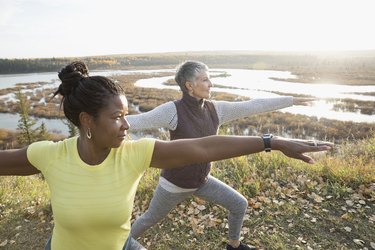
Improving your balance may not be your number one fitness goal, but it should definitely be high on the list. Why? Because balance affects every other area of your life — including your workouts.
Think about it: Even walking around requires stability, as does bending down to pick something up, going up the stairs or climbing onto a step stool, not to mention exercises like running, lifting weights and yoga.
Better Balance Now Means Healthier Aging Later
Balance is crucial regardless of your age or activity level. The main reason why is also the most obvious: Increasing your stability means you're less likely to stumble and fall. The older we get, the more prone we are to slips and injuries. In fact, one in four American adults over the age of 65 falls each year, and those falls result in three million emergency room visits, according to the U.S. Centers for Disease Control and Prevention.
Working on your balance also strengthens the support around your joints, which helps keep them healthy in the long run. It also helps injuries (like ankle sprains) heal faster because it improves proprioception, aka your sense where your body is in the space around you, which typically suffers after you get hurt. Even better, there are about as many ways to improve balance as there are benefits, so you can find the exercise approach that's best for you.
Balance Exercises for Beginners
First, start with the basics. How well do you fare balancing on one leg? Could you hold that position forever, or do you feel like you'll topple over immediately? Does that change if you're standing on carpet or a hard floor? How do your left and right legs compare? Once you have a sense of your balance baseline, you can work on strengthening the core and lower-body muscles that play a role in your stability.
From lunges to speed skaters and even a homemade obstacle course, there are a variety of easy exercises you can do at home or anywhere else you have the time and space. Or if you've identified a particular area of weakness, you can try incorporating strengthening moves specifically for your feet and ankles, knees or hips. Check out the list of balance exercises below and start adding some to your daily routine.
Here's everything you need to know about basic balance exercises.
Use a BOSU Ball
Once you've mastered the basics of body-weight balance training, you may want to start incorporating some equipment into the mix. The BOSU ball (aka balance trainer) — you know, that half-flat, half-stability-ball-looking thing at your gym — is a great place to start.
BOSU, which stands for "both sides up," is a versatile piece of fitness equipment that you can use for rehabbing an injury or amping up the intensity of exercises like planks, squats, push-ups and glute bridges. Not sure where to start? Check out our recommendations below.
Here's how to get started with BOSU ball exercises.
Do Some Stability Ball Exercises
Similar in function to the BOSU ball, a stability ball (sometimes called a Swiss ball) also takes your core workout to the next level, and increased core strength (think: abs, obliques, back and hip flexors) means better balance. Plus, it's much easier to stock your home gym with a stability ball as opposed to trying to build a full-on workout room at home.
You can take common exercises like hamstring curls, chest presses and sit-ups and perform them on a stability ball, or you can check out the list below for ways to get creative with this gym staple, including reaching rear lunges and balancing kickbacks.
Here's everything you need to know about stability ball exercises.
Try a Balance Board
The balance board has always been a popular fitness gadget among certain groups of exercisers (like surfers), but this workout tool has become a bit more mainstream in recent years. It's a fun way to improve your stability and spatial awareness, and you can use it in your living room or even at your standing desk.
It can be a bit tricky to get the hang of using a balance board at first, which is why we created the beginner's guide below. We've covered all the basics, from the benefits of standing on a balance board to the best exercises to start with and how to do them safely to everything you need to know about different board brands.
Here's everything you need to know about balance boards.
Practice Standing Yoga Poses
Yoga might be one of the first things you think about when you're working on improving your balance, and with good reason: Every standing yoga pose — from Mountain to Half Moon — helps you build a solid strength foundation from the ground up.
One of the (many) great things about practicing yoga is that it's modifiable for any fitness level. New to yoga? Start with grounding poses like Warrior I and II so you have both feet on the floor. If you're a bit more advanced and looking for a challenge, take flight with single-leg poses like Tree pose and even Standing Splits. For even more standing yoga poses, read through the following list.
Here's everything you need to know about standing yoga poses.
Challenge Yourself With Yoga Balance Poses
There are loads of other yoga balance poses that challenge your stability but don't involve standing on your own two feet. Start with core-strengthening yoga poses like Plank and Side Plank, and then move onto more advanced poses like Crow, Headstand and Handstand.
These poses may not eliminate all of your klutzy moments, but they can help improve balance and stability, which means you'll move with more grace overall, and prevent injuries. And as an added bonus, not only will you move through your external environment with ease, you'll have a stronger mind-body connection as well.
Here's everything you need to know about yoga balance poses.